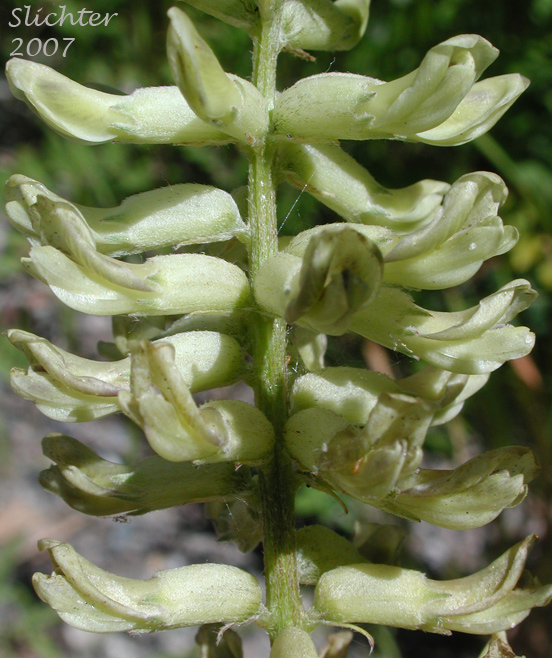
Canada milk-vetch is a robust perennial wildflower with ascending to erect stems from 15-100 cm high arising singly or several together from spreading rhizomes. The leaves and stems are covered with short, fine, appressed hairs or may be green and glabrous. The pinnately compound leaves are 5-35 cm long with 13-35 leaflets measuring 10-45 mm long and broadly lanceolate, oblong, ovate or elliptic in outline.
The erect flower stems are 4-22 cm long. The densely flowered racemes elongate to 2.5-16 cm long and 2.5-3.5 cm wide when mature and bear up to 150 flowers. The calyx is bell-shaped but assymetrical at its base (See photo above.) and measures 4.5-8.5 mm long with awl-shaped to triangular teeth from 1-4 mm long. It is covered with whitish to black hairs that are appressed to the calyx tube or spreading. The petals are greenish-white or whitish-yellow or may be purple-tinged. The moderately recurved banner is 12-17.5 mm long while the wings are 10-15 mm long and the obtuse keel is 10-13.5 mm long. The erect, sessile pod is oblong-cylindric or ellipsoid in shape with an abruptly rounded base. The pods measure 8-20 mm long and 3-5 mm wide and are covered with minute, appressed hairs or are glabrous.
Canada milk-vetch may be found in vernally to permanently moist places along streams, in prairie or in woodland.
Canada milk-vetch may be found from northern British Columbia south to central California, central Nevada and southwestern Utah. It is found eastward to James Bay, Ontario and New England and south to South Carolina. It is found south through the Rocky Mts. to north-central New Mexico and eastward to southeastern Texas.